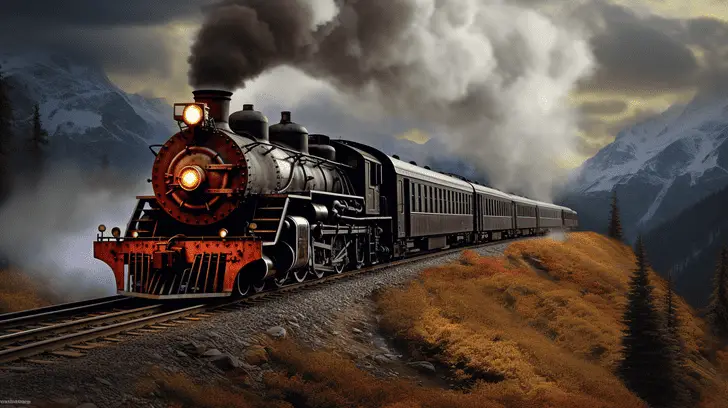Did you know that the LNER Class A Mallard steam locomotive holds the world record for speed? This iconic train reached an astonishing speed of 202.58 km/h (126 mph) in 1938, a record for steam locomotives that still stands to this day.

In this article we’ll look at 25 interesting facts about historic steam trains.
- Technology Evolution: Steam trains played a pivotal role in the 18th-century industrial revolution. They dramatically changed the way we traveled, transported goods, and connected with the world.
- Steam Train Pioneer: George Stephenson, an English engineer, is considered the “Father of Railways”. He built the first functional steam locomotive in 1814.
- First Train Race: “The Rainhill Trials” of 1829 was the first steam train race. George Stephenson’s “Rocket” locomotive won the contest.
- Steam Train vs. Horse: Before steam trains, horses were the primary mode of transport. With an average speed of 48 km/h, steam trains could travel four times faster than a horse.
- Contribution to Globalization: Steam trains made the rapid expansion of railway networks possible, connecting cities, countries, and entire continents. This accelerated globalization and had a significant impact on economic development.
- Large-Scale Locomotives: The largest steam locomotives ever built were the Big Boy locomotives, used in America in the 20th century. They were 40 meters long and could pull trains of up to 4,200 tons.
- Development in War: During World War I and II, steam trains were essential for transporting troops and military equipment.
- The Last Steam Locomotive: British Railways built the last steam locomotive, the “Evening Star”, in 1960. This marked the end of the steam train era in Britain.
- Long Lifespan: A steam train can operate for over 50 years if it is well-maintained. Some of today’s steam locomotives were built in the 19th century.
- Revolution in Communication: Before the telephone, the telegram sent by train was the fastest form of long-distance communication.
READ MORE: What are train tracks made of? - Steam Train Tourism: Today, many steam trains are preserved as tourist attractions and are used for nostalgic journeys.
- Steam Train in Pop Culture: Steam trains have often been depicted in pop culture, the most famous being the Hogwarts Express from the Harry Potter series.
- Notion of Standard Time: Steam trains contributed to the establishment of standard time zones, to avoid confusion in train schedules.
- Speed Record: The LNER Class A Mallard holds the world record for the fastest steam locomotive, reaching a speed of 202.58 km/h in 1938.
- First Commercial Railway Line: The Liverpool-Manchester railway line, opened in 1830, was the first successful commercial line to use only steam locomotives.
- Invention of Train Tickets: In 1830, George Stephenson invented the train ticket system to manage the large number of passengers.
- First Transcontinental Line: In 1869, the first transcontinental railway line in the U.S. was completed, linking the East with the West of the country.
- Stories of the Orient Express: Known for luxury and mystery, the Orient Express was one of the most famous steam trains, inspiring many stories and novels.
- Role in the American Revolution: Steam trains played a crucial role in the American Industrial Revolution, facilitating the transport of goods and people over long distances.
- Steam Trains in India: India has one of the largest railway networks in the world, many of its initial lines were operated by steam trains.
READ MORE: What sound does a train make? - First Train Station: The Mount on the Oystermouth Railway (later to become Swansea and Mumbles) was opened in 1807 and is considered the world’s first train station.
- Steamboat Willie: The first successful sound animated film, “Steamboat Willie”, featuring Mickey Mouse, was inspired by steam trains.
- Coal Operation: Most steam trains operate by burning coal to heat water and generate steam. This powers the pistons that move the wheels.
- Last Bastion of Steam Trains: Even in the modern era, some countries like North Korea and Zimbabwe still use steam trains for freight and passenger transport.
- Restoration and Conservation: Many old steam trains are restored and conserved by enthusiasts and museums, thereby keeping the legacy of these historic machines alive for future generations.
READ MORE: How wide is a train car?
Steam trains capture our fascination due to their historic significance, intricate mechanical design, and nostalgic appeal. They offer a tangible link to our past, marking a pivotal era of industrial advancement that revolutionized transportation and trade, thereby shaping the modern world. The intricacy of their operation, characterized by the mesmerizing sight of billowing steam and rhythmic chugging, stirs a sense of awe and provides a unique, immersive experience that modern trains simply cannot replicate.





